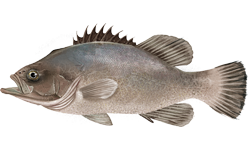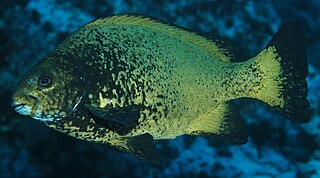
Acropomatidae is a family of fish in the order Perciformes, commonly known as lanternbellies. Acropoma species are notable for having light-emitting organs along their undersides. They are found in all temperate and tropical oceans, usually at depths of several hundred meters. There are about 32 species in as many as 9 genera, although some authorities recognise fewer genera than Fishbase does.

Anablepidae is a family of fishes which live in brackish and freshwater habitats from southern Mexico to southern South America. There are three genera with sixteen species: the four-eyed fishes, the onesided livebearers and the white-eye, Oxyzygonectes dovii. Fish of this family eat mostly insects and other invertebrates.

Anthias are members of the family Serranidae and make up the subfamily Anthiinae. The name Anthiidae is preoccupied by a subfamily of ground beetles in the family Carabidae created by Bonelli in 1813 and this grouping should be called the Anthiadinae. However, both the 5th Edition of Fishes of the World and Fishbase give the Serranid subfamily as "Anthiinae".

The wreckfish are a family, Polyprionidae in the suborder Percoidei of the order Perciformes.

Trichogaster is a genus of gouramis native to South Asia from Pakistan to Myanmar. It is the only genus in the monotypic subfamily Trichogastrinae as set out in the 5th Edition of Fishes of the World, although that book states that there are two genera, the other being Colisa which is treated as a synonym of Trichogaster by Fishbase and the Catalog of Fishes. Fishbase also places the genus in the Luciocephalinae. Species of this genus are very popular in the aquarium trade.

The sea chubs, also known as rudderfish and pilot fish and in Hawaiian as enenue or nenue, are a family, Kyphosidae, of fishes in the order Perciformes native to the Atlantic, Indian and Pacific Oceans usually close to shore in marine waters.
Menidia is a genus of Neotropical silversides native to freshwater, brackish and marine habitats along the Atlantic and Gulf of Mexico coasts of North America, ranging from the Gulf of Saint Lawrence in Canada to the Yucatán Peninsula in Mexico. The species M. clarkhubbsi, an all-female species, reproduces asexually.

Percichthys is a genus of temperate perches native to freshwater habitats in Argentina and Chile.

Characodon is a genus of splitfins endemic to north–central Mexico. Two of the species are highly threatened and restricted to pools, ponds and springs in the upper San Pedro Mezquital River basin in Durango. The third species, C. garmani, was restricted to springs near Parras in Coahuila, but it became extinct when they dried out.
Bahaba is a genus of marine ray-finned fishes belonging to the family Sciaenidae, the drums and croakers. These fishes are found in the Indo-West Pacific region.

Dermatolepis is a genus of marine ray-finned fish, groupers from the subfamily Epinephelinae, part of the family Serranidae, which also includes the anthias and sea basses. They are found in the western Atlantic, Pacific and Indian Oceans.

Phallostethidae, also known as priapium fish, is a family of atheriniform fish native to freshwater and brackish habitats in southeast Asia.

Bangana is a genus of fish in the family Cyprinidae, the carps and minnows. It is distributed across much of southern and eastern Asia. Species live mainly in the flowing waters of tropical and subtropical rivers.

Hypoatherina is a genus of silversides in the family Atherinidae.

Fodiator is a genus of flying fishes. It is the only genus in the subfamily Fodiatorinae.

Satyrichthys is a genus of marine ray-finned fish belonging to the family Peristediidae, the armoured gurnards or armored searobins. These fishes are found in the Indo-Pacific region.

Malakichthys is a genus of fish in the family Acropomatidae, the temperate ocean-basses or lanternfishes. They are native to the Indian Ocean and the western Pacific Ocean.

Pseudocaranx is a genus of ray-finned fishes from the family Carangidae, the jacks, trevallies, scads, and pompanos. They occur in the western Atlantic Ocean and the Indo-Pacific.

Photopectoralis is a genus of marine ray-finned fishes, ponyfish from the family Leiognathidae. They are native to the Indian Ocean and the western Pacific Ocean.

Macropodus is a genus of small to medium-sized labyrinth fish native to freshwater habitats in eastern Asia. Most species are restricted to southern China and Vietnam, but M. opercularis occurs as far north as the Yangtze basin, and M. ocellatus occurs north to the Amur River, as well as in Japan and Korea. In China, they are often used for fights, so they are named Chinese bettas because of their similarity to the genus Betta. A few species in the genus are regularly seen in the aquarium trade, and M. opercularis has been introduced to regions far outside its native range.

















